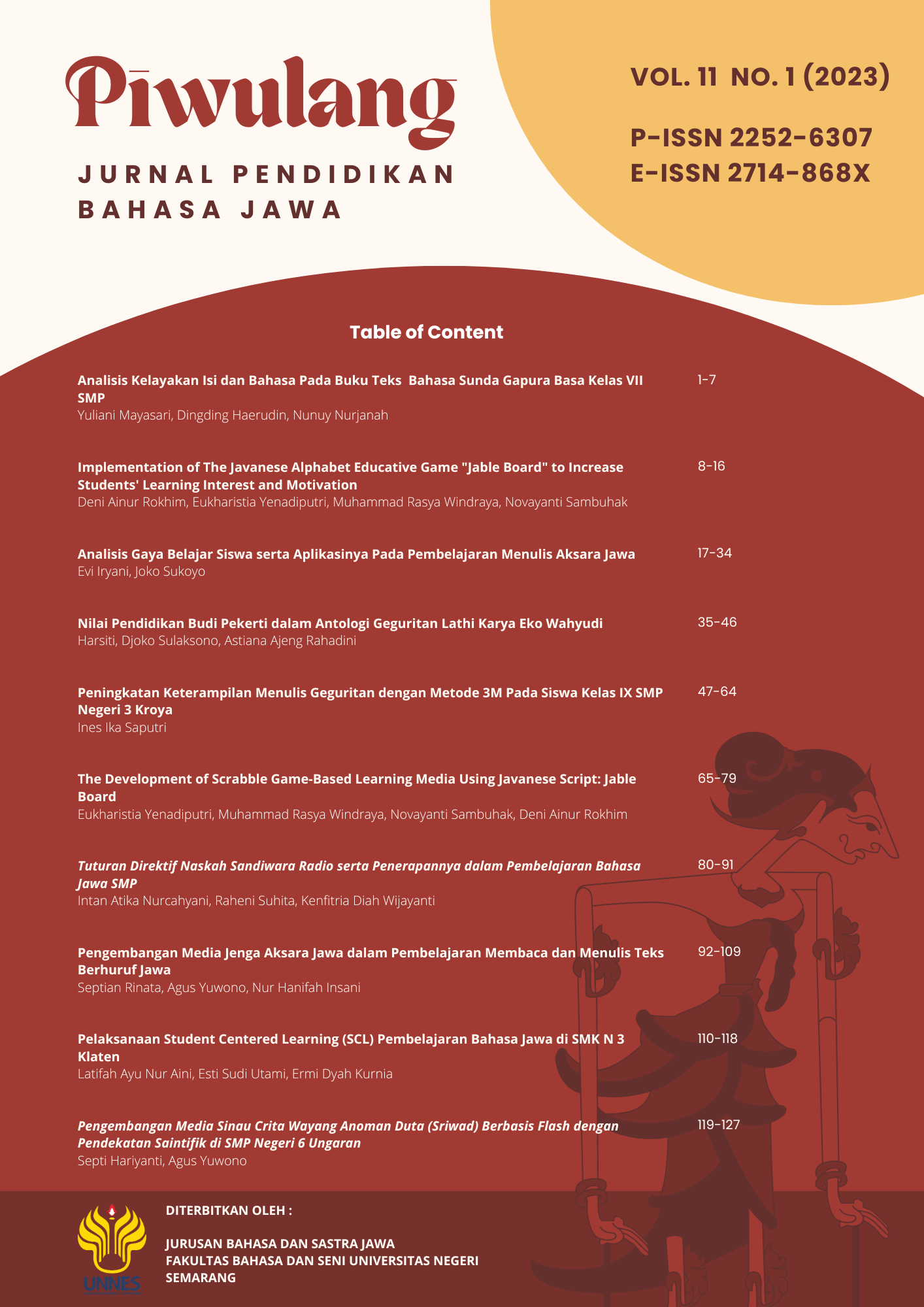Analisis Gaya Belajar Siswa dan Hubungannya dengan Hasil Belajar Menulis Aksara Jawa
##plugins.themes.academic_pro.article.main##
Abstract
This study aims to describe the relationship between student learning styles and student learning outcomes in learning the Javanese language to write Javanese alphabet at SMP Darussalam Bergas. This research is a qualitative descriptive with 100 students of class VIII as the research subject. Data were collected through observation, interviews, questionnaires, and documentation. Analysis of the data using the analytical model of Miles and Huberman. The research steps consist of data collection, data reduction, data presentation, and drawing conclusions. The results of the study concluded that the learning styles of class VIII students when learning to write Javanese alphabet were 48% visual, 32% auditory, and 205 kinesthetic. Students who score above the cut score are dominated by auditory learning style, while students who score below the cut score are dominated by visual learning styles. The results of observations of students who have a visual learning style prefer to see the visual appearance of Javanese characters on the blackboard rather than just listening to the teacher's explanation. Students with an auditory learning style cannot concentrate if the class is in a crowded atmosphere. While students with a kinesthetic learning style prefer learning that involves students directly, they also cannot linger just sitting quietly and listening to the teacher's explanation.
##plugins.themes.academic_pro.article.details##
References
Ayuningtyas, I., & Minarti, I. B. (2021). Analisis Gaya Belajar Terhadap Hasil Belajar Siswa Kelas X di SMA Institut Indonesia Semarang. Jurnal Ilmiah Edukasia, 1(1), 41–50. https://doi.org/10.26877/jie.v1i1.7963
Azzahrah Putri, R., Magdalena, I., Fauziah, A., & Nur Azizah, F. (2021). Pengaruh Gaya Belajar terhadap Pembelajaran Siswa Sekolah Dasar. Cerdika: Jurnal Ilmiah Indonesia, 1(2), 157–163. https://doi.org/10.36418/cerdika.v1i2.26
Bobbi, D., & Hernacki, M. (2015). Quantum Learning : Membiasakan Belajar Nyaman dan Menyenangkan (S. Meutia, ed.). Band: Kaifa.
Cabual, R. A. (2021). Learning Styles and Preferred Learning Modalities in the New Normal. OALib, 08(04), 1–14. https://doi.org/10.4236/oalib.1107305
Chislett, V. Ms., & Chapman, A. (2005). VAK Learning Styles Self-Assessment Questionnaire (Online). Retrieved from m www.businessballs.com
Cicilia, Y., & Nursalim, N. (2019). Gaya dan Strategi Belajar Bahasa. Edukatif : Jurnal Ilmu Pendidikan, 1(3), 138–149. https://doi.org/10.31004/edukatif.v1i3.30
Delić, H. (2020). The Analysis of Learning Styles Among High School Students. Journal of Education and Humanities, 3(1), 17–28. https://doi.org/10.14706/jeh2019222
Diniaty, A., Fauzi’Ah, L., Febriana, B. W., & Arlianty, W. N. (2018). Analysis of Students Learning Style Preference as Initial Steps in Determining Strategy of Learning. AIP Conference Proceedings, 2–7. https://doi.org/10.1063/1.5065017
Glazunova, O., Morze, N., Golub, B., Burov, O., Voloshyna, T., & Parhomenko, O. (2020). Learning Style Identification System: Design and Data Analysis. CEUR Workshop Proceedings, 2732, 793–807.
Hamdani, D. Al. (2015). Exploring Students’ Learning Style at a Gulf University: A Contributing Factor to Effective Instruction. Procedia - Social and Behavioral Sciences, 176, 124–128. https://doi.org/10.1016/j.sbspro.2015.01.452
Jamulia, J. (2018). Identifying Students Learning Style Preferences at Iain Ternate. International Journal of Education, 10(2), 121–129. https://doi.org/10.17509/ije.v10i2.1631
Kim, H., Sefcik, J. S., & Bradway, C. (2017). Characteristics of Qualitative Descriptive Studies: A Systematic Review. Research in Nursing and Health, 40(1), 23–42. https://doi.org/10.1002/nur.21768
Latifah, N. N. (2019). Pembelajaran Muatan Lokal Bahasa Jawa dalam Pelaksanaan Kurikulum 2013 di SDN Sambiroto 01. JPD: Jurnal Pendidikan Dasar, 10(1), 149–158.
Maric, M., Penger, S., Todorovic, I., Djurica, N., & Pintar, R. (2015). Differences in Learning Styles: A comparison of Slovenian Universities. Procedia - Social and Behavioral Sciences, 197(February), 175–183. https://doi.org/10.1016/j.sbspro.2015.07.079
Pardede, K., Ahmad, M., & Harahap, M. S. (2021). Analisis Gaya Belajar Serta Pengaruh Terhadap Hasil Belajar Matematika Siswa Selama Pandemi Covid-19. JURNAL MathEdu (Mathematic Education Journal), 4(2), 243–252. https://doi.org/10.37081/mathedu.v4i2.2526
Peraturan Daerah Provinsi Jawa Tengah Nomor 9 Tahun 2012 tentang Bahasa, Sastra Dan Aksara Jawa
Sarfa Wassahua. (2016). Gaya Belajar, Hasil Belajar Matematika. 2(1), 84–104. https://doi.org/http://dx.doi.org/10.33477/mp.v4i1.310
Sari, L. O. (2020). Gaya Belajar Siswa dalam Proses Pembelajaran Bahasa Indonesia pada Kelas V Sd Negeri 113 Bengkulu Selatan. Institut Agama Islam Negeri (IAIN) Bengkulu, Bengkulu.
Sholikhah, A. A., & Ismail. (2018). Profil Berpikir Kritis Siswa SMP dalam Memecahkan Masalah Matematika Kontekstual Ditinjau dari Gaya Belajar VAK. MATHEdunesa Jurnal Ilmiah Pendidikan Matematika, 7(3), 518–525. https://doi.org/https://doi.org/10.26740/mathedunesa.v7n3.p518-525
Thalmann, S. (2014). Adaptation Criteria For The Personalised Delivery of Learning Materials: A Multi-Stage Empirical Investigation. Australasian Journal of Educational Technology, 30(1), 45–60. https://doi.org/10.14742/ajet.235
Truong, H. M. (2016). Integrating Learning Styles and Adaptive E-Learning System: Current Developments, Problems and Opportunities. Computers in Human Behavior, 55, 1185–1193. https://doi.org/10.1016/j.chb.2015.02.014
Wahab, I., & Nuraeni, N. (2020). The Analysis of Students’ Learning Style. Scope of English Language Teaching, Literature and Linguistics, 3(1), 41–46. https://doi.org/10.46918/seltics.v3i1.509
Wahyuni, Y. (2017). Identifikasi gaya belajar (Visual, Auditorial, Kinestetik). Jurnal Penelitian Dan Pembelajaran Matematika, 10(2), 128–132. https://doi.org/10.30870/jppm.v10i2.2037
